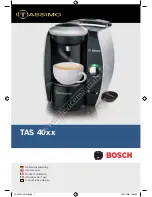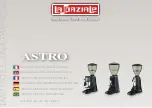
12
1. Place a sufficiently large cup or glass under the coffee
spouts (A11);
2. Press the button corresponding to the quantity to be mod-
ified and hold it down until the light flashes and the appli-
ance starts delivering coffee, then release;
3. When the coffee in the cup reaches the desired level, press
the same button again to memorise the new amount. (See
the table in section “12.4 Coffee delivery”).
The machine is now reprogrammed with the new quantities.
14. MAKING CAPPUCCINO
Danger of burns!
During preparation steam is given off. Take care to avoid scalds.
1. When preparing cappuccino, make the coffee in a large
cup;
2. Fill a container (preferably one with a handle to avoid
scalding) with about 100 grams of milk for each cappuc-
cino. When choosing the appropriate size of container, re-
member that the milk doubles or triples in volume;
Please note:
For a richer and denser froth, use skimmed or partially skimmed
milk from the refrigerator (about 5°C). To avoid producing milk
with poor froth or large bubbles, always clean the cappuccino
maker as described in the section “16. Cleaning”.
3. Models with adjustable cappuccino maker only:
Make sure the cappuccino maker selection ring (A20) is po-
sitioned downwards in the "CAPPUCCINO" position (fig. 18);
4. The cappuccino maker (A18) can be turned slightly out-
wards to allow containers of any size to be used;
5. Immerse the cappuccino maker in the milk container;
6. Press the
button (B4);
7. When the light in the
button flashes after a few
seconds, turn the steam dial (A21) to the
I
position (fig.
6). Steam is delivered from the cappuccino maker, giving
the milk a creamy frothy appearance and making it more
voluminous;
8. For a creamier froth, swirl the container slowly, moving it
from the bottom upwards. (Steam should not be generat-
ed by the machine for more than 3 minutes continuously).
9. When you have obtained the required froth, stop steam
delivery by turning the dial to the "
0
" position.
Danger of burns!
Interrupt steam delivery before removing the container with the
frothed milk to avoid burns caused by splashes of boiling milk.
10. Add the milk froth to the coffee prepared previously. The
cappuccino is ready. Sweeten to taste and, if desired, sprin-
kle the froth with a little cocoa powder.
Please note!
If “Energy saving” is active, you may have to wait a few seconds
before steam is delivered.
14.1 Cleaning the cappuccino maker after use
Clean the cappuccino maker (A18) each time you use it to avoid
the build-up of milk residues or blockages.
Danger of burns!
When cleaning the cappuccino maker, a little hot water is de-
livered. Take care to avoid contact with splashes of hot water.
1. Deliver a little water by turning the steam/hot water dial
(A21) to the
I
position. Then stop delivery by turning the
dial back to the
0
position.
2. Wait a few minutes for the cappuccino maker to cool down.
Turn the cappuccino maker downwards to remove it (fig.
19).
3. Models with adjustable cappuccino maker only:
Move the ring (A20) upwards until the hole shown in fig.
20 is uncovered.
4. Remove the nozzle (A19) downwards (fig. 21).
5. Make sure the two holes shown by the arrow in fig. 22 are
not blocked. If necessary, clean with a pin.
6. Reinsert the nozzle and replace the cappuccino maker
on the nozzle, pushing it upwards and turning it until it is
attached.
15. DELIVERING HOT WATER
Important! Danger of scalding.
Never leave the machine unattended when hot water is re-
leased. The spout of the cappuccino maker (A18) becomes hot
during delivery.
1. Place a container under the cappuccino maker (as close as
possible to avoid splashes).
2. Turn the steam/hot water dial (A21) to the
I
position (fig.
6).
3. To stop hot water delivery manually, turn the steam/hot
water dial to the
0
position.
Please note!
If “Energy Saving” is active, you may have to wait a few seconds
before hot water and steam are delivered..
16. CLEANING
16.1 Cleaning the machine
The following parts of the machine must be cleaned regularly:
- internal circuit of the machine;
- coffee grounds container (A13);
- drip tray (A14), drip tray grille* (A15) and condensate tray
(A12);































